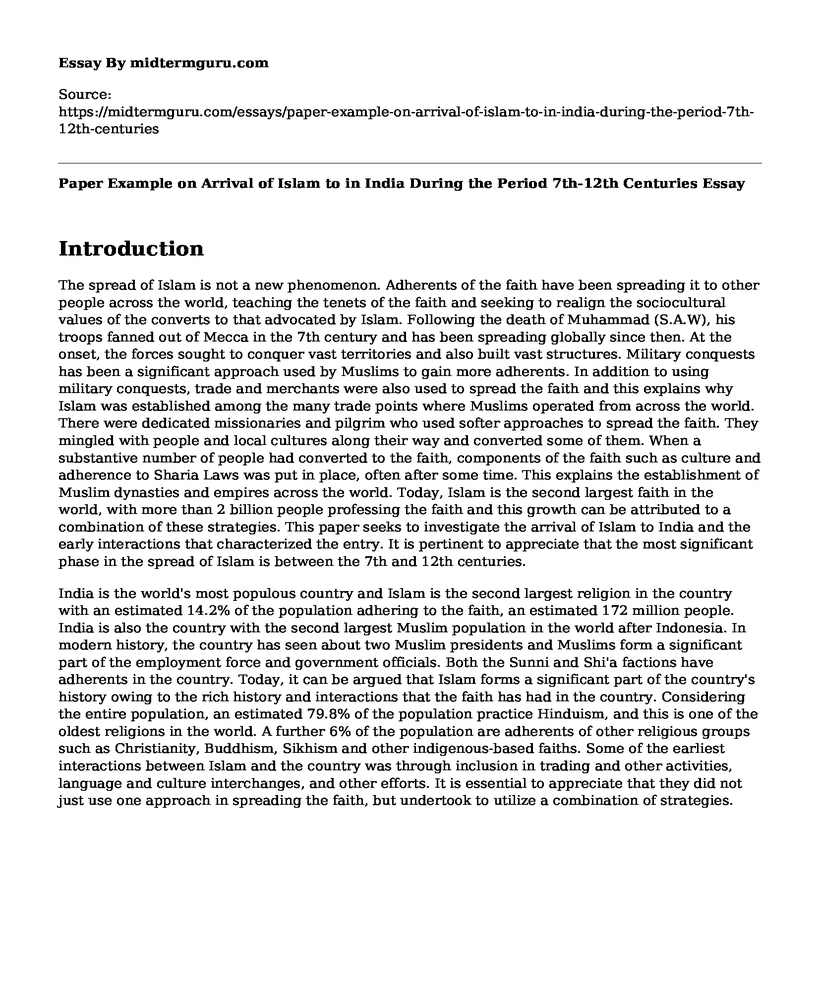Introduction
The spread of Islam is not a new phenomenon. Adherents of the faith have been spreading it to other people across the world, teaching the tenets of the faith and seeking to realign the sociocultural values of the converts to that advocated by Islam. Following the death of Muhammad (S.A.W), his troops fanned out of Mecca in the 7th century and has been spreading globally since then. At the onset, the forces sought to conquer vast territories and also built vast structures. Military conquests has been a significant approach used by Muslims to gain more adherents. In addition to using military conquests, trade and merchants were also used to spread the faith and this explains why Islam was established among the many trade points where Muslims operated from across the world. There were dedicated missionaries and pilgrim who used softer approaches to spread the faith. They mingled with people and local cultures along their way and converted some of them. When a substantive number of people had converted to the faith, components of the faith such as culture and adherence to Sharia Laws was put in place, often after some time. This explains the establishment of Muslim dynasties and empires across the world. Today, Islam is the second largest faith in the world, with more than 2 billion people professing the faith and this growth can be attributed to a combination of these strategies. This paper seeks to investigate the arrival of Islam to India and the early interactions that characterized the entry. It is pertinent to appreciate that the most significant phase in the spread of Islam is between the 7th and 12th centuries.
India is the world's most populous country and Islam is the second largest religion in the country with an estimated 14.2% of the population adhering to the faith, an estimated 172 million people. India is also the country with the second largest Muslim population in the world after Indonesia. In modern history, the country has seen about two Muslim presidents and Muslims form a significant part of the employment force and government officials. Both the Sunni and Shi'a factions have adherents in the country. Today, it can be argued that Islam forms a significant part of the country's history owing to the rich history and interactions that the faith has had in the country. Considering the entire population, an estimated 79.8% of the population practice Hinduism, and this is one of the oldest religions in the world. A further 6% of the population are adherents of other religious groups such as Christianity, Buddhism, Sikhism and other indigenous-based faiths. Some of the earliest interactions between Islam and the country was through inclusion in trading and other activities, language and culture interchanges, and other efforts. It is essential to appreciate that they did not just use one approach in spreading the faith, but undertook to utilize a combination of strategies.
Cite this page
Paper Example on Arrival of Islam to in India During the Period 7th-12th Centuries. (2022, Sep 28). Retrieved from https://midtermguru.com/essays/paper-example-on-arrival-of-islam-to-in-india-during-the-period-7th-12th-centuries
If you are the original author of this essay and no longer wish to have it published on the midtermguru.com website, please click below to request its removal:
- Essay on The Parable of the Unforgiving Slave: The Forgiveness
- Essay on the Thoughts of Augustine in the City of God
- Divine Command Theory - Religion Essay Example
- Paper Example on History of Indonesia in the 20th Century and the Role of Islam
- The Pilgrim's Progress - Critical Essay Sample
- Essay Sample on Islam and Feminism
- History of Buddhism - Essay Sample







